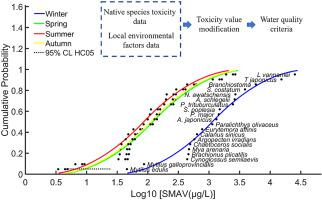Environmental Pollution ( IF 7.6 ) Pub Date : 2022-06-21 , DOI: 10.1016/j.envpol.2022.119666 Yang Li 1 , Di Mu 1 , Hong-Qing Wu 1 , Dan-Dan Tan 1 , Xian-Hua Liu 2 , Jun Sun 3 , Zhi-Yong Ji 1

|
Copper has become one of the most important heavy metal pollutants in the environment because of its wide application and high toxicity, but research on water quality criteria (WQCs) on copper is limited, especially the derivation of seawater WQC. In addition, the toxicity of copper in the seawater system is affected by various environmental factors. Therefore, establishing a WQC that meets the characteristics of the regional environment is a top priority. The correlations between four factors of temperature, salinity, pH, dissolved organic carbon (DOC) and the toxic effect values of copper were analyzed in this study, and the temperature was determined as the most influential factor among the four factors in the Bohai Sea. A specific correlation between temperature and the toxic effects of copper was identified, and WQCs were derived based on the identified correlation and the variations of the Bohai Sea's temperature in different seasons by species sensitivity distribution (SSD) method. Under the condition of the winter, spring, autumn, and summer with an average water temperature of 0.09, 15.96, 17.83, and 24.87 °C, the obtained short-term water quality criteria (SWQCs) were 44.29, 4.70, 4.31, and 3.33 μg/L; the long-term water quality criteria (LWQCs) were 18.14, 1.93, 1.77 and 1.36 μg/L. The findings indicated the importance of introducing specific environmental conditions during the derivation process. This work could provide valuable information for pollution prevention and aquatic life protection in the Bohai Sea and provide a valuable reference for the derivation of criteria in other regions alike.
中文翻译:

考虑多种环境因素对铜毒性影响的渤海铜水质标准推导
铜因其用途广泛、毒性大而成为环境中最重要的重金属污染物之一,但对铜的水质标准(WQCs)研究有限,尤其是海水WQC的推导。此外,海水系统中铜的毒性还受各种环境因素的影响。因此,建立符合区域环境特点的WQC是当务之急。本研究分析了温度、盐度、pH、溶解有机碳(DOC)4个因子与铜毒效应值之间的相关性,确定温度是渤海4个因子中影响最大的因子。确定了温度与铜的毒性作用之间的特定相关性,和WQCs是基于识别的相关性和渤海温度在不同季节的变化,通过物种敏感性分布(SSD)方法得出的。在冬、春、秋、夏平均水温分别为0.09、15.96、17.83和24.87℃的条件下,得到的短期水质标准(SWQCs)分别为44.29、4.70、4.31和3.33微克/升;长期水质标准(LWQCs)分别为18.14、1.93、1.77和1.36 μg/L。研究结果表明在推导过程中引入特定环境条件的重要性。该工作可为渤海污染防治和水生生物保护提供有价值的信息,为其他地区的标准推导提供有价值的参考。











































 京公网安备 11010802027423号
京公网安备 11010802027423号